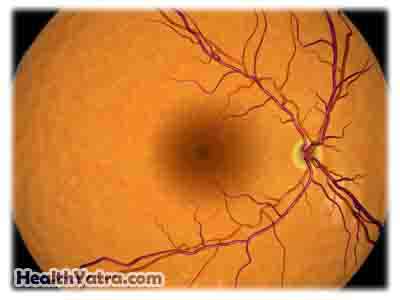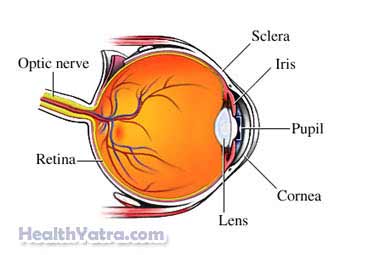تعريف
Retinoblastoma is a rare type of cancer found in the eye. In retinoblastoma, one or more tumors form in the retina. The retina is a layer of light-sensitive tissue that lines the back of the eye. It converts visual images into nerve impulses in the brain that allow us to see. If not treated, the tumors will continue growing. The cancer may grow along the optic nerve and reach the brain or it may travel to other parts of the body.
Cancer occurs when cells in the body (in this case retina cells) divide without control or order. Normally, cells divide in a regulated manner. If cells keep dividing uncontrollably when new cells are not needed, a mass of tissue forms, called a growth or tumor. Tumors can invade nearby tissue and spread to other parts of the body.

أسباب
During early stages of fetal development, fast-growing, immature cells called retinoblasts form. Later, these cells become retinal cells. In retinoblastoma, some of these cells quickly grow out of control. Some cases of the tumor are inherited; others are not. Retinoblastoma usually forms only in one eye, but both eyes may have tumors.
عوامل الخطر
A risk factor is something that increases your chance of getting a disease or condition. Risk factors for retinoblastoma include:
- Age: less than 5 years old (typically)
- Family members with retinoblastoma
الأعراض
Symptoms are usually noticed by the parent or caregiver and may include, but are not limited to:
- Eyes do not look normal, often described as a glazed look or a “cat’s eye.”
- When a light is directed at the eye, the pupil looks white rather than red. This is often noticed on a photograph.
- Eyes may appear to be crossed or looking in different directions.
- قد تشمل الأعراض الأقل شيوعًا ما يلي:
- Eye may grow in size
- Eye pain
- Redness in the white part of the eye
- Tearing
- Pupil may not respond to light
- Iris (colored part of the eye) changes color

التشخيص
The doctor will ask about symptoms and family medical history, and perform a physical exam. Many retinoblastomas are found during routine physical exams. If a tumor is suspected, the child will usually be referred to a specialist for a more complete eye exam. In children with a family history of the disease, eye exams often begin within a day or two of birth. Additional eye exams are scheduled at regular intervals thereafter.
Once retinoblastoma is found, staging tests are performed to find out if the cancer has spread, and, if so, to what extent. Treatment depends on the stage of the cancer. The cancer may be localized to the eyes or it may have spread to tissues around the eye or to other parts of the body.
Tests may include, but are not limited to:
- Eye exam—The pupil is dilated with eye drops. Then, the inside of the eye is examined with a lighted instrument that allows the examiner to view structures inside the eye.
- Ultrasound—This test that uses sound waves to examine the inner part of the eye.
- MRI scan —The MRI uses magnetic waves to make pictures of the inside of the body. It can be used to check for spread of the cancer to the brain or other tissue.
- CT scan —This is a type of x-ray that uses a computer to make pictures of the eye. CT scans of other areas of the body may be done to check if the cancer has spread.
General anesthesia may be given to keep the child still during close examination and testing.
العلاج
Your child will likely be referred to a specialist for treatment. Without treatment, the cancer cells will continue to grow.
Treatment aims to cure the cancer and preserve sight. Options vary, depending on whether the disease is limited to the eye or has spread, and how large and where in the eye the tumor is located. Therapies may be used alone or in combination.
تشمل العلاجات ما يلي:
جراحة
This involves surgical removal of the entire eye and as much of the optic nerve as possible. The optic nerve is the nerve leading from the eye to the brain that is responsible for vision. Surgery may be used for a large tumor in one eye.
علاج إشعاعي
This treatment involves the use of radiation to kill cancer cells and shrink tumors. Radiation may be:
- العلاج الإشعاعي الخارجي – الإشعاع الموجه إلى الورم من مصدر خارج الجسم
- الإشعاع الداخلي therapy—radioactive materials placed into the body near the cancer cells
العلاج بالتبريد
Used on small tumors, cryotherapy is the use of cold to freeze and destroy cancer cells.
Thermotherapy
This treatment uses heat to kill cancer cells.
Photocoagulation
Lasers are used to destroy a small tumor.
العلاج الكيميائي
Chemotherapy is the use of drugs to kill cancer cells. This treatment may be given in many forms including pill, injection, and through a catheter. The drugs enter the bloodstream and travel through the body killing mostly cancer cells, but also some healthy cells.
الوقاية
Genetic counseling and close monitoring and screening for people at risk for retinoblastoma can help prevent the disease or detect it early if it occurs.
Early diagnosis and treatment improve the chance of successful treatment. Prevention and early detection techniques include:
- Screening—Children born into families with a history of retinoblastoma should have regular eye exams to screen for development of the tumor. All children should have regular eye screening by their doctor.
- Genetic counseling—This may help determine a person’s risk of developing retinoblastoma. If you have retinoblastoma or have a family history of the disorder, you can talk to a genetic counselor when deciding to have children.
- Monitoring for recurrence—People who have been treated for retinoblastoma require regular medical exams to assess the success of treatment and check for recurrence or bilateral disease.
- Monitoring for other cancers—Children with retinoblastoma are at increased risk for an associated brain tumor and other cancers in the body.
